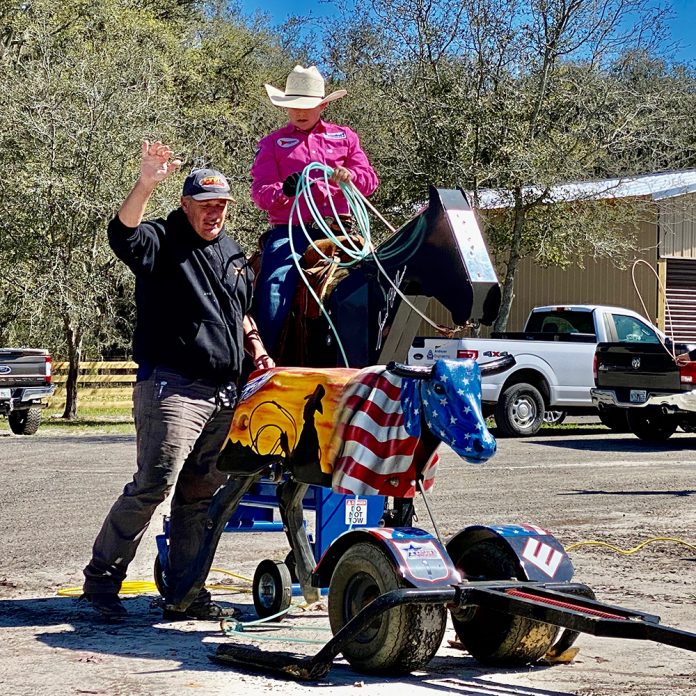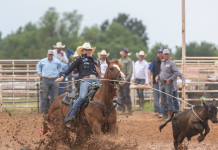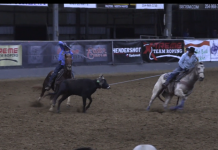Breaking it Down by Speed Williams – June 2024
Recently I taught a school of kids in Orange, Texas, with six headers and four heelers. I truly enjoy teaching people to rope. It’s something I’ve spent my whole life studying and working at. It’s amazing how fast kids can learn and improve. But, like all young boys, heading or heeling, they want to throw fast. The majority of these kids are numbered at #3 and #4. One of the first things was I wanted them to be able to catch under 11-seconds first. That means being able to execute a high team run. When you start practicing on the first cow, make sure your horse runs into position, catch, and handle the steer… versus reaching a coil, letting your horse duck, and give a bad handle. So many heelers want to square up on the corner and throw their rope because often times that’s the best shot they will get.
We start out by roping steers and then watch the video and break it down. I ask heelers to give me some time to work with the headers. Once I get the headers handling steers, they can get better looks and see what’s coming. Then it becomes easier to be a heeler.
Next, I put the dummy close to the Speed Trainer and have them get their rope ready. When I say, “Ready, set, go,” they have to drop their left hand, put weight in the stirrups, have their butt out of the saddle while wiggling their legs, take two swings and rope the horns, pull the slack, and dally without ever pulling on the reins. Watching them work at this drill amazes me how fast young people can learn and adapt.
Then I move the dummy out further and have them make the right leg stay still and the left leg kick. This teaches them to use their legs to go to the cow and not just pull on the reins. Then they do a drill on the ground where they run to the dummy take two swings and rope on the gain while they’re getting there. This teaches them to calculate closing the gap while gaining. My goal is to teach them not to panic when they get close. When running forward they want to throw their rope down when actually they need to be coming across the horns.
Learning to rope faster comes from riding your horse across the line and not pulling on the reins. The majority of the kids use the bridle reins way too much. Once I had the headers doing a better job, then the heelers were able to ride their horse and heel the steer like a high team shot. The goal for #3 and #4 ropers is to get in position and take high percentage shots. But if your header does not keep control of the steer’s head and lets him drift down the arena, it’s very difficult to catch if you don’t throw on the corner. That’s why it’s call team roping.
It makes a huge different when the header gets out and is able to rope in the first third of the arena instead of at the end when everything is going wide open and is out of control. It’s difficult for heelers, especially in low numbered ropings, when headers don’t handle the steer correctly. I would watch my headers rope the steer, then their horse would step out because their right leg was in, and their left leg was out. Once they got a dally and went left, they tried to slow up and the cow’s head goes towards the stripping chute making him difficult to heel. By the end of the school the difference in the runs the kids were able to put together was amazing.
Team roping is very difficult if you and your partner don’t work together to get better and understand the little things you can do to help during the run. Using video is an important part of my schools. Often when you point something out, it doesn’t make sense until they see themselves on video when we break it down. Then it makes sense.
One of the neat things about the Speed Trainer is the height is adjustable, so you can easily simulate the height of your horse. I’m a believer in creating angles of roping live steers, so the closer you can make it to real life, the better your practice session can be.
For all of you in school… team roping is all about math and angles and understanding what your horse thinks. When he tells you he’s hurting figure out what you can do to make him feel better. When we get new horses there are several things I do, including getting their teeth done. Then I send them to the vet at Signature Equine to have them checked over. Then I have a horse chiropractor work on them. It makes a difference if your horse suddenly quits working. One of those three things can tell you a lot about your horse. Also, if you have a new bridle, saddle, or pad and your horse starts acting out, you might want to change back to what you were using and see if that fixes the problem. Sometimes horses don’t like new gear or doesn’t like the bridle. If he’s trying to tell you something, don’t just run another ten on him. Try and figure out what’s bothering him.
What’s new with us: I won’t say Hali is healed, but she can run 25 or 30 calves a day though she still has discomfort in her foot. My son has been having an adventure for the last couple of months. He’s been cowboying and doing day work on the Spade Ranch. The next couple of weeks he’ll be at Dean Tuftin’s riding working cow horses, reiners, and getting to spend some time with some premier horsemen. I sure am loving my Priefert walker. I held off getting one when we built our indoor and didn’t realize how much I missed it.




